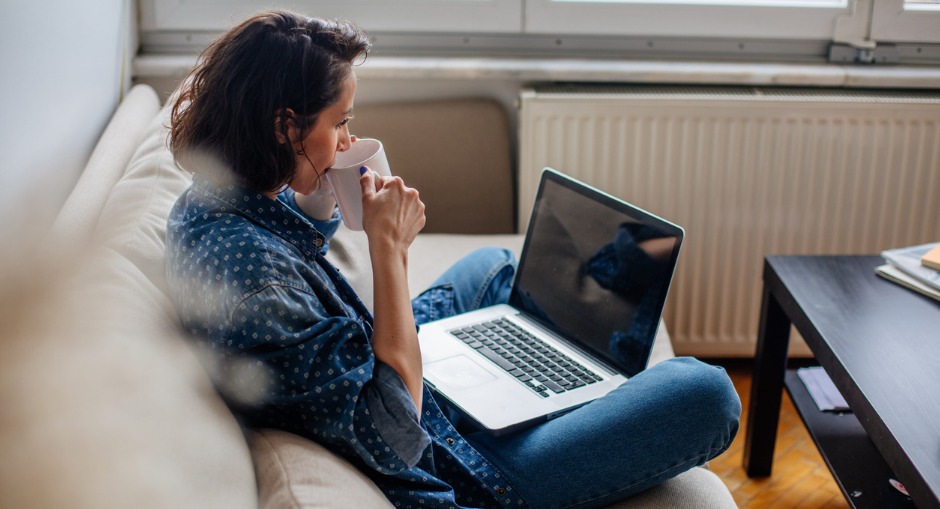
Thousands of Australian workers left the office to spend more time working from home to protect their health from COVID-19. But what many didn’t realise was the hidden dangers of working from home.
They set up to work from their kitchen table, the breakfast bar or couch with little thought to the ergonomics. Working from the couch for an hour a day probably wouldn’t be a problem, but eight hours a day, five days a week is likely to lead to pain or musculoskeletal injury in the future.
While you don’t need to replicate your entire office at home, you need some basic equipment to keep you safe from injury. Follow our advice for the optimal home office setup.
Adjust the Height of the Screen
Compared to a desktop computer, laptops are convenient when you’re moving between home and office or even room to room. But they aren’t designed to be used all day sitting on your desk or your lap. The problem is their screen height. It’s not at eye level, so your neck bends down to allow you to read the screen. It’s also common for laptop users to extend their head forward when looking down at the screen in an unnatural position.
By raising the height of the laptop with a monitor riser or using a separate monitor solves the problem of incorrect neck and shoulder posture or ‘laptopitis’. Sit directly in front of the screen so you aren’t looking down or across to see the screen. Keeping your neck and back straight helps avoid injury.
Move Around
When you were in the office, you no doubt stood up regularly to visit a colleague, walk to a meeting or grab some papers off the printer. But now you’re home, there may be fewer reasons to get up from your chair or take a break.
Your lack of movement throughout the work day is increasing your chances of an overuse injury and health problems caused by sedentary work. Occupational overuse syndrome (OOS) most commonly impacts the fingers, hands, wrists and elbows and is usually caused by repetitive movements or awkward postures.
Altering between sitting and standing positions throughout the day can reduce the chance of an injury. Consider upgrading your work environment with a sit stand desk or standing desk converter. Research shows the optimal workstation setup allows you to stand for one hour after every one to two hours of sitting. If you decide to use a desk converter to save space, be sure to choose a good quality one. Some are too heavy or high for a worker to change the height while other converters aren’t sturdy enough that they won’t tip off your desk.
In the meantime, remind yourself to get up from your chair every 30 minutes for a stretch or a walk around the backyard so your muscles aren’t in the same position for long periods.
Upgrade the Dining Chair
Kitchen and dining chairs are designed for sitting to eat your nightly meal, not for sitting on all day to work. The problem is they aren’t adjustable for height or back support, so the body is forced to conform to the chair rather than the other way around. Sitting at the kitchen table may cause you to slouch back in the chair or perch on the front of the seat and lean towards your computer. With 4 million Australians already suffering back problems, we need to be mindful about our seated posture, so we don’t make the problem worse.
A good quality office chair improves your posture and reduces the risk of pain or injury. The right chair also increases your level of comfort while working. Being comfortable not only reduces the risk of pain or injury but also reduces the fatigue, which makes us unproductive.
When choosing a new ergonomic office chair, make sure it conforms to the Australian Standard AS/NZS 4438-1997 (“Height-adjustable swivel chairs”).
Noise and Light
If you’re finding the house noisy and difficult to concentrate, you aren’t alone. The extra noise of children, pets, and the neighbours can trigger your body’s stress response system, which releases stress hormones to cope. Invest in noise cancelling headphones to dampen the din and give you some peace and quiet to concentrate.
Home lighting is quite different to office lighting. If you’re struggling to read the computer screen easily, you’re more likely to sit forward and extend your neck in an unnatural position. You may need a desk light if the overhead light is casting a shadow and if glare on your screen is a problem, adjust the blinds.
Making the transition from workplace to home might seem easy, but to keep yourself safe, you need to consider the differences in your environment. It may not be evident now that there’s a problem because musculoskeletal injuries take time to develop. Thousands of people could be sitting on a ticking time bomb that’s due to go off in future years.
If you have any queries about office equipment you can use to improve your home office setup, don’t hesitate to call us on (08) 9240 7066 or contact us online.